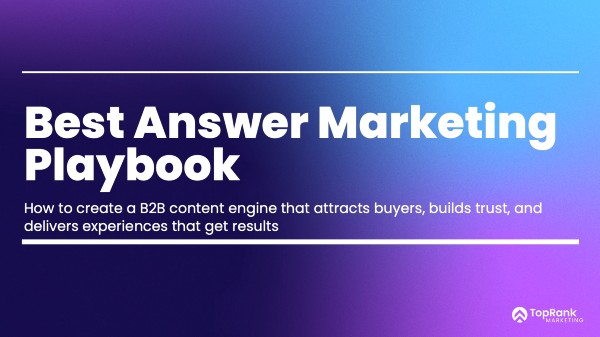There’s a lot of metaphors to represent what B2B marketing leaders are dealing with in the current environment, but feeing like you’re trying to conduct a symphony in the middle of a hurricane seems to fit.
On one side, you have C-level leadership demanding clearer ROI and more efficient growth. On the other, you have a buying committee that’s larger, more cautious, and more fragmented than ever before. And in the middle of it all, the channels you’ve relied on from search engines to social networks are being fundamentally reshaped by AI.
It’s no wonder so many B2B marketers feel like they’re running faster just to stay in the same place. The old playbooks are simply worn out.
We’ve talked a lot recently about the individual forces causing this turbulence. After Google’s I/O event this year, we analyzed the massive shift towards AI Overviews and what it means for discovery. We’ve shared case studies showing how an integrated approach can drive incredible results.
And for over a decade, since I first wrote about it in Optimize, we’ve advocated for a timeless marketing strategy we call “be the best answer” that connects B2B brands with buyers whether they’re chasing a top position amongst 10 blue links or navigating visibility amongst zero click behavior.
But what happens when these forces converge at once?
You get a Complexity Crisis. B2B marketers are not simply facing one new challenge to solve; it’s the intersection of multiple pressures that makes the current environment so uniquely challenging. In particular, it’s a reality for B2B marketers that is defined by three core challenges:
1. The Fractured Buyer Journey:
Information discovery for B2B buyers used to be a fairly predictable path, heavily weighted toward a Google search and even social networks like LinkedIn. Marketers optimizing for search visibility would identify topic clusters and even long tail keywords to inform content creation and optimization.
Today, it’s more like the long tail of discovery. Buyers are increasingly getting their answers from generative AI, ask for recommendations in private communities and sources like Reddit and Substack, consult peers, follow influencers and creators and engage across numerous different channels before ever speaking to a sales rep. Omnichannel experiences are the expectation and if you’re not discoverable in the right format across this entire ecosystem, you’re invisible.
2. The Crisis of Credibility:
In a world drowning in content, buyers have developed a powerful skepticism filter. They are tuning out anything that sounds like a traditional marketing pitch and especially any content that appears AI-generated. Without genuine trust that is earned through the sources of credibility that buyers actually rely on, from credible experts to authentic customer stories, and objective data, even the most visible content can be ignored. Great content isn’t so great until it’s seen and believed.
3. Increased Pressure to Perform:
While the external environment has gotten more complex, internal demands for marketing performance and efficiency have increased. B2B marketing budgets are under increased scrutiny. Business leaders are placing more confidence in technology than humans, making marketing team headcount more precious than ever. Expectations of measurable impact on the pipeline and revenue from every program have grown. Understandably and given these pressures and challenges, there is zero tolerance for “random acts of marketing.”
Trying to solve each of these challenges separately is a lost cause. A better SEO strategy won’t solve your trust problem. A great influencer marketing campaign won’t fix a fractured data picture. And overconfidence in AI to generate content is not the same thing as creating marketing experiences that perform.
Marketers who are working through this level of complexity can benefit from a connected approach that brings strategy, content, SEO, and influence together. At TopRank Marketing, we have developed solutions that help brands build trust, improve discovery, and create meaningful momentum across the full marketing ecosystem.
Tackling this Complexity Crisis requires a fresh and yet proven way of thinking. It requires an operating system of sorts, a framework that connects data with insights and an integrated strategy with omnichannel tactics. An approach that ensures every action builds on the last and brings clarity to the chaos. This operating system of clarity that we’ve developed and now refined is called Best Answer Marketing.
To help our community of B2B marketing professionals dealing with this complexity crisis is why we are launching a new series of posts.
In this series, we’ll lay out a practical, actionable playbook for navigating this new reality of how to become the best answer for your customers. We’ll break down this B2B marketing framework we call Best Answer Marketing into its core components, dedicating a post to each critical pillar. We’ll move from the ‘why’ to the ‘how,’ providing a clear path forward for building a content marketing and trust engine that will help you thrive in today’s environment.
This series is for the B2B marketer who knows the game has changed and is ready for a strategy designed for the future vs. “the way we’ve always done it.”
Next week, we’ll tackle the foundational pillar that underpins every successful marketing program: the role of data in understanding the questions buyers need answered in order to trust, engage and buy.
Get the Best Answer Marketing Playbook First

We’re building the Best Answer Marketing Playbook in public through this new series of posts. To get a copy, sign up below and when the series is complete, we’ll send you the Best Answer Marketing Playbook including an exclusive strategy checklist and bonus resources.
Best Answer Marketing Playbook – Blog Post Series:
Introduction to BAM: Escape the Chaos of B2B Marketing with the Best Answer Marketing Playbook
Pillar 1, Data Informed: From Data Overload to Data-Informed: Solving Content Blind Spots with Best Answer Marketing
Pillar 2, Integrated Strategy: Insights to Impact: Why Integrated Strategy is the Core of Best Answer Marketing
Pillar 3, Trust Engine: Building Credibility at Scale: The Trust Engine in Best Answer Marketing
Pillar 4, Experiential Content: Facts Tell, Stories Sell: The Role of Experiential Content in Best Answer Marketing
Pillar 5, Multi-Channel Discovery: The Power of Multi-Channel Discovery in Best Answer Marketing
Pillar 6, Full Funnel Analytics: Best Answer Marketing Measurement and Optimization with Full Funnel Analytics
BAM Action Plan: Is Best Answer Marketing Right for You? The BAM Action Plan



